1997 MERCEDES-BENZ ML500 ABS
[x] Cancel search: ABSPage 3098 of 4133
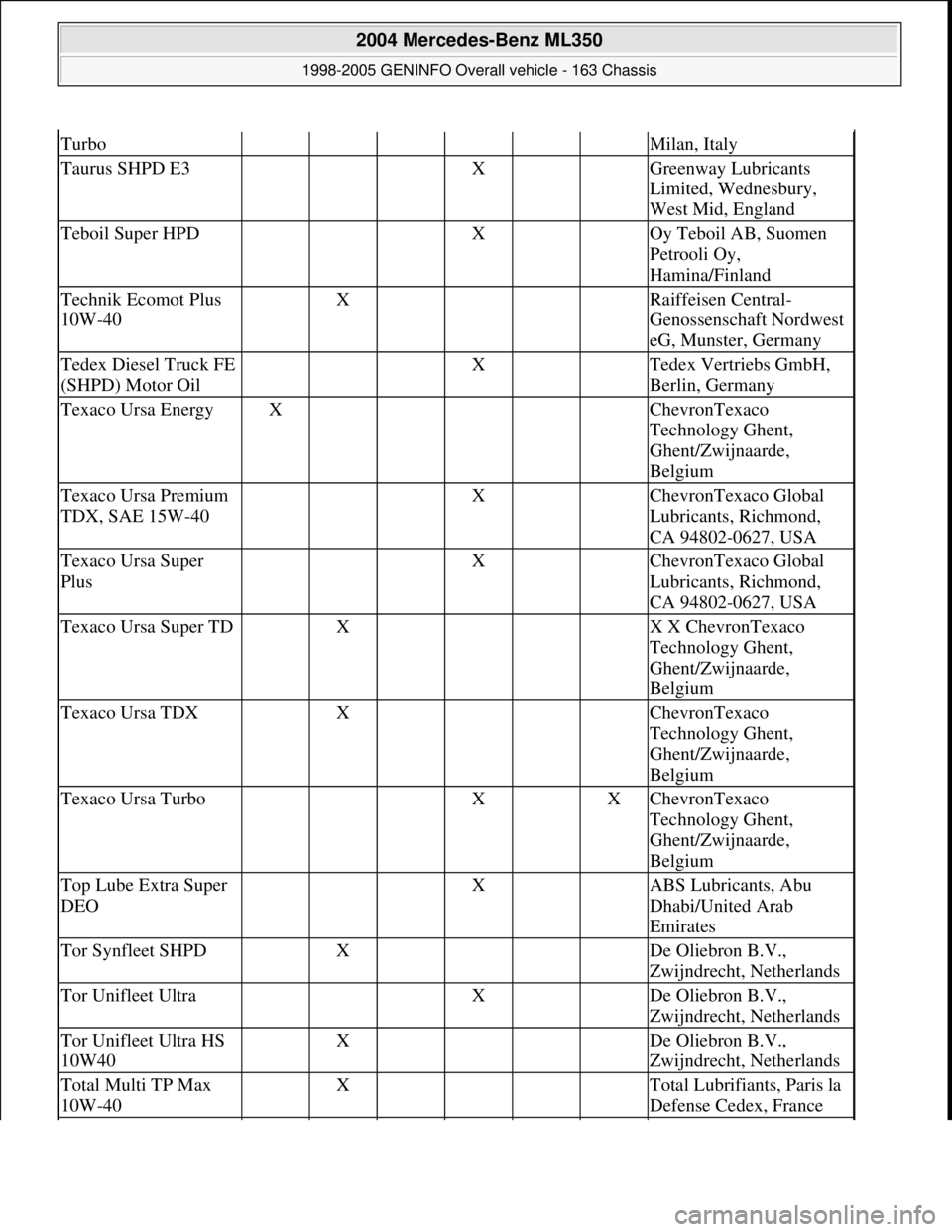
TurboMilan, Italy
Taurus SHPD E3 X Greenway Lubricants
Limited, Wednesbury,
West Mid, England
Teboil Super HPD X Oy Teboil AB, Suomen
Petrooli Oy,
Hamina/Finland
Technik Ecomot Plus
10W-40 X Raiffeisen Central-
Genossenschaft Nordwest
eG, Munster, Germany
Tedex Diesel Truck FE
(SHPD) Motor Oil X Tedex Vertriebs GmbH,
Berlin, Germany
Texaco Ursa EnergyX ChevronTexaco
Technology Ghent,
Ghent/Zwijnaarde,
Belgium
Texaco Ursa Premium
TDX, SAE 15W-40 X ChevronTexaco Global
Lubricants, Richmond,
CA 94802-0627, USA
Texaco Ursa Super
Plus X ChevronTexaco Global
Lubricants, Richmond,
CA 94802-0627, USA
Texaco Ursa Super TD X X X ChevronTexaco
Technology Ghent,
Ghent/Zwijnaarde,
Belgium
Texaco Ursa TDX X ChevronTexaco
Technology Ghent,
Ghent/Zwijnaarde,
Belgium
Texaco Ursa Turbo X XChevronTexaco
Technology Ghent,
Ghent/Zwijnaarde,
Belgium
Top Lube Extra Super
DEO X ABS Lubricants, Abu
Dhabi/United Arab
Emirates
Tor Synfleet SHPD X De Oliebron B.V.,
Zwijndrecht, Netherlands
Tor Unifleet Ultra X De Oliebron B.V.,
Zwijndrecht, Netherlands
Tor Unifleet Ultra HS
10W40 X De Oliebron B.V.,
Zwijndrecht, Netherlands
Total Multi TP Max
10W-40 X Total Lubrifiants, Paris la
Defense Cedex, France
2004 Mercedes-Benz ML350
1998-2005 GENINFO Overall vehicle - 163 Chassis
me
Saturday, October 02, 2010 3:47:54 PMPage 453 © 2006 Mitchell Repair Information Company, LLC.
Page 3156 of 4133
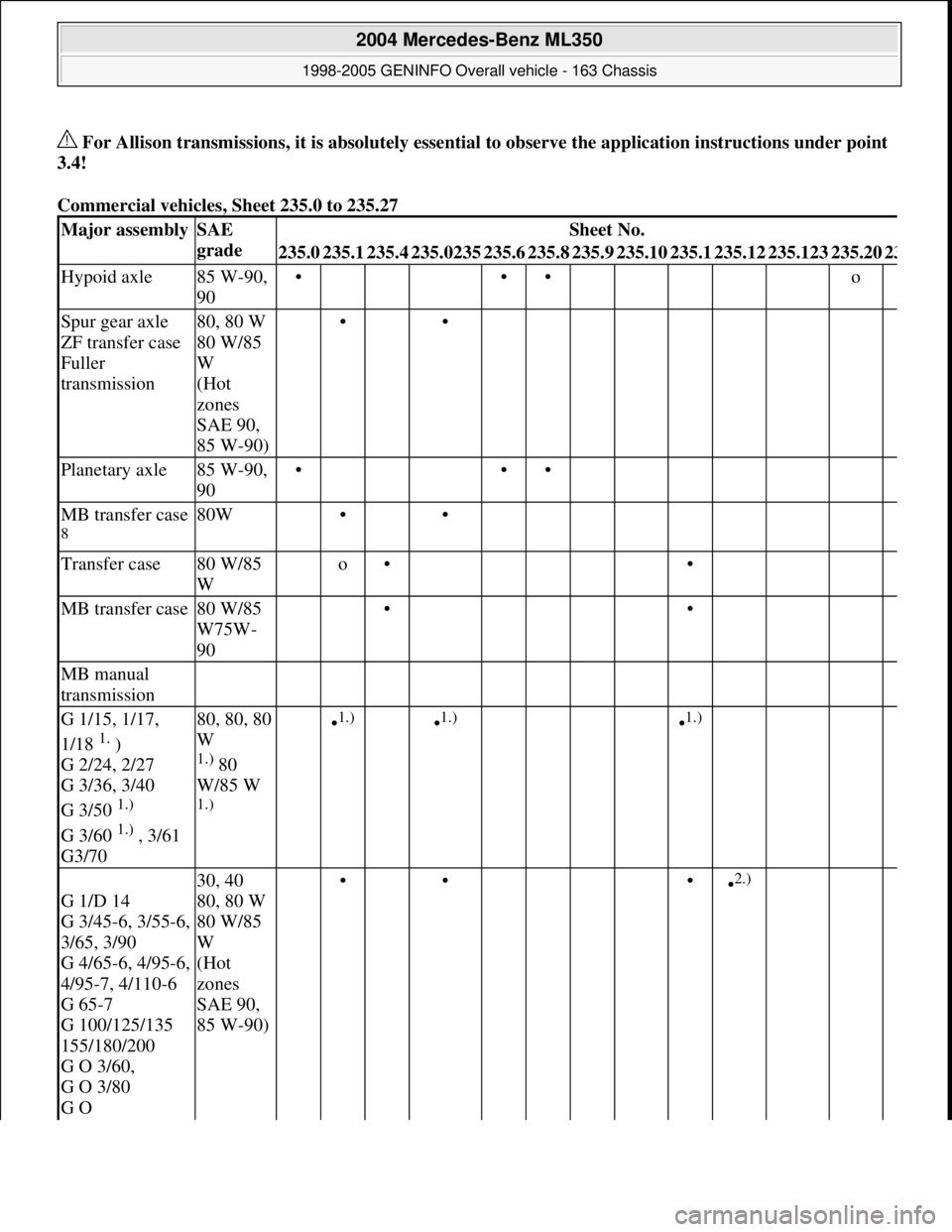
For Allison transmissions, it is absolutely essential to observe the application instructions under point
3.4!
Commercial vehicles, Sheet 235.0 to 235.27
Major assemblySAE
gradeSheet No.
235.0235.1235.4235.0235235.6235.8235.9235.10235.1235.12235.123235.2023
Hypoid axle85 W-90,
90• •• o
Spur gear axle
ZF transfer case
Fuller
transmission80, 80 W
80 W/85
W
(Hot
zones
SAE 90,
85 W-90) • •
Planetary axle85 W-90,
90• ••
MB transfer case
8
80W • •
Transfer case80 W/85
W o• •
MB transfer case80 W/85
W75W-
90 • •
MB manual
transmission
G 1/15, 1/17,
1/18
1. )
G 2/24, 2/27
G 3/36, 3/40
G 3/50
1.)
G 3/60
1.) , 3/61
G3/70
80, 80, 80
W
1.) 80
W/85 W
1.)
•1.) •1.) •1.)
G 1/D 14
G 3/45-6, 3/55-6,
3/65, 3/90
G 4/65-6, 4/95-6,
4/95-7, 4/110-6
G 65-7
G 100/125/135
155/180/200
G O 3/60,
G O 3/80
G O 30, 40
80, 80 W
80 W/85
W
(Hot
zones
SAE 90,
85 W-90) • • ••2.)
2004 Mercedes-Benz ML350
1998-2005 GENINFO Overall vehicle - 163 Chassis
me
Saturday, October 02, 2010 3:47:56 PMPage 511 © 2006 Mitchell Repair Information Company, LLC.
Page 3158 of 4133
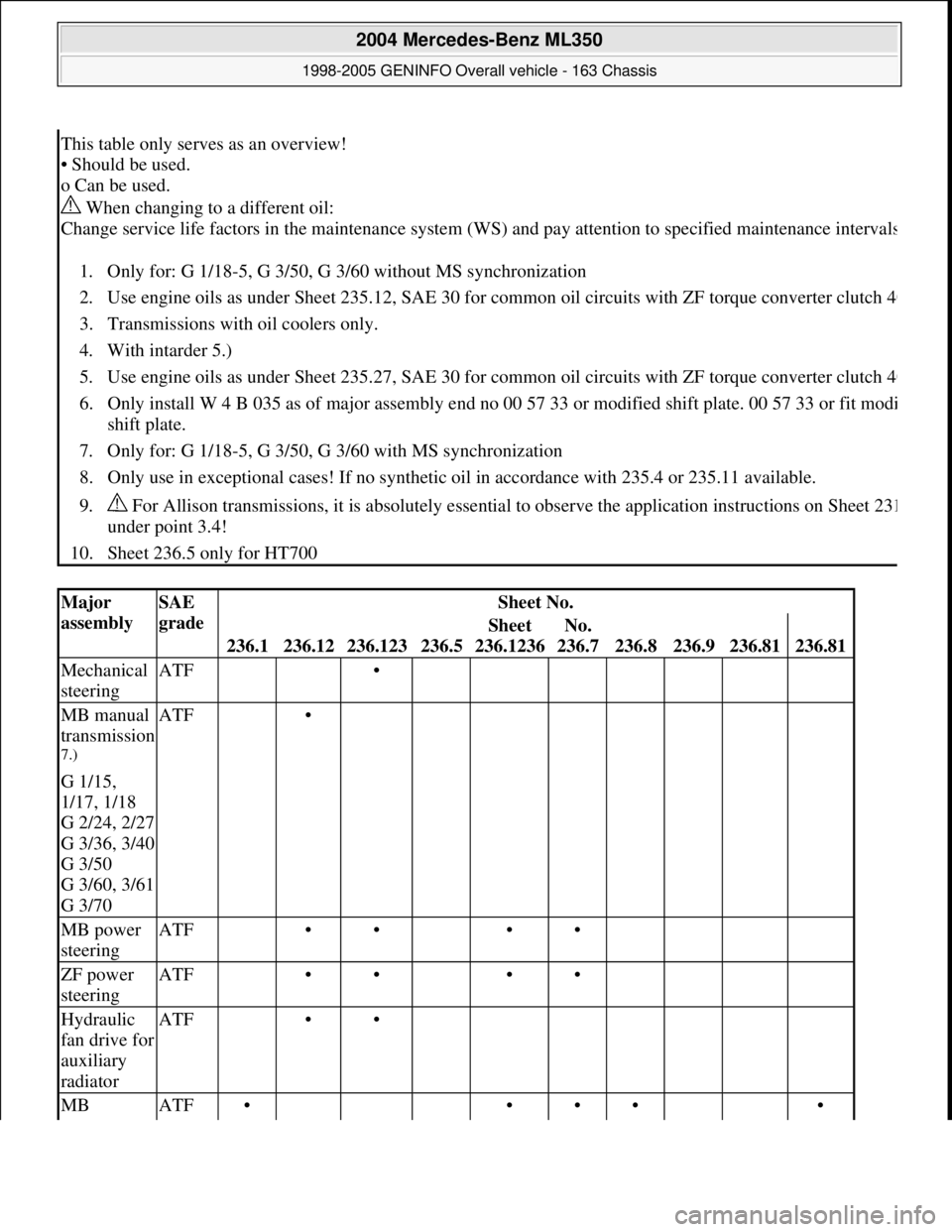
This table only serves as an overview!
• Should be used.
o Can be used.
When changing to a different oil:
Change service life factors in the maintenance system (WS) and pay attention to specified maintenance interval
s
1. Only for: G 1/18-5, G 3/50, G 3/60 without MS synchronization
2. Use engine oils as under Sheet 235.12, SAE 30 for common oil circuits with ZF torque converter clutch 4
0
3. Transmissions with oil coolers only.
4. With intarder 5.)
5. Use engine oils as under Sheet 235.27, SAE 30 for common oil circuits with ZF torque converter clutch 4
0
6. Only install W 4 B 035 as of major assembly end no 00 57 33 or modified shift plate. 00 57 33 or fit modi
shift plate.
7. Only for: G 1/18-5, G 3/50, G 3/60 with MS synchronization
8. Only use in exceptional cases! If no synthetic oil in accordance with 235.4 or 235.11 available.
9. For Allison transmissions, it is absolutely essential to observe the application instructions on Sheet 23
1
under point 3.4!
10. Sheet 236.5 only for HT700
Major
assemblySAE
gradeSheet No.
236.1236.12236.123236.5
Sheet
236.1236No.
236.7
236.8236.9236.81236.81
Mechanical
steeringATF •
MB manual
transmission
7.)
G 1/15,
1/17, 1/18
G 2/24, 2/27
G 3/36, 3/40
G 3/50
G 3/60, 3/61
G 3/70
ATF •
MB power
steeringATF •• ••
ZF power
steeringATF •• ••
Hydraulic
fan drive for
auxiliary
radiatorATF ••
MB ATF• ••• •
2004 Mercedes-Benz ML350
1998-2005 GENINFO Overall vehicle - 163 Chassis
me
Saturday, October 02, 2010 3:47:56 PMPage 513 © 2006 Mitchell Repair Information Company, LLC.
Page 3159 of 4133
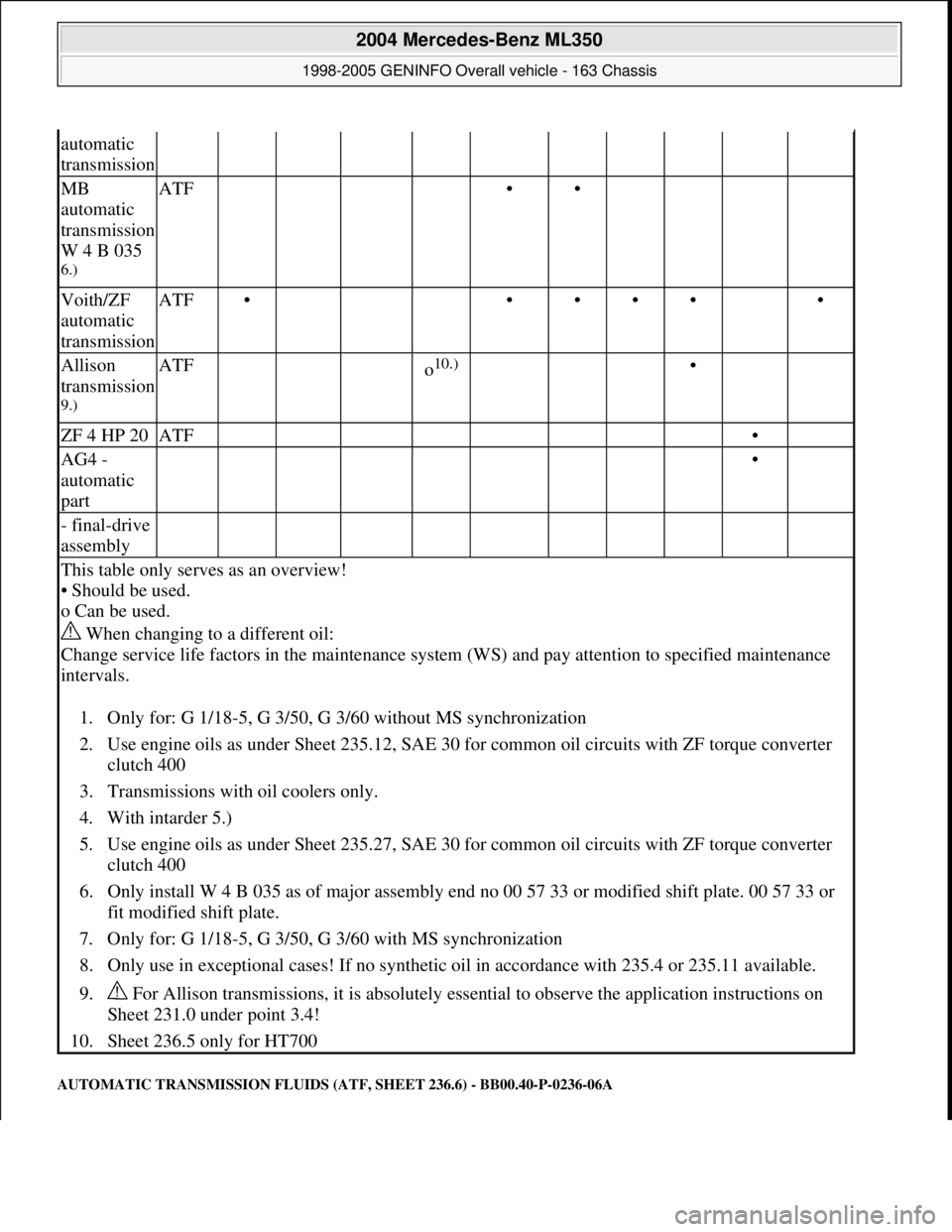
AUTOMATIC TRANSMISSION FLUIDS (ATF, SHEET 236.6) - BB00.40-P-0236-06A
automatic
transmission
MB
automatic
transmission
W 4 B 035
6.)
ATF ••
Voith/ZF
automatic
transmissionATF• •••• •
Allison
transmission
9.)
ATF o10.) •
ZF 4 HP 20ATF •
AG4 -
automatic
part •
- final-drive
assembly
This table only serves as an overview!
• Should be used.
o Can be used.
When changing to a different oil:
Change service life factors in the maintenance system (WS) and pay attention to specified maintenance
intervals.
1. Only for: G 1/18-5, G 3/50, G 3/60 without MS synchronization
2. Use engine oils as under Sheet 235.12, SAE 30 for common oil circuits with ZF torque converter
clutch 400
3. Transmissions with oil coolers only.
4. With intarder 5.)
5. Use engine oils as under Sheet 235.27, SAE 30 for common oil circuits with ZF torque converter
clutch 400
6. Only install W 4 B 035 as of major assembly end no 00 57 33 or modified shift plate. 00 57 33 or
fit modified shift plate.
7. Only for: G 1/18-5, G 3/50, G 3/60 with MS synchronization
8. Only use in exceptional cases! If no synthetic oil in accordance with 235.4 or 235.11 available.
9. For Allison transmissions, it is absolutely essential to observe the application instructions on
Sheet 231.0 under point 3.4!
10. Sheet 236.5 only for HT700
2004 Mercedes-Benz ML350
1998-2005 GENINFO Overall vehicle - 163 Chassis
me
Saturday, October 02, 2010 3:47:56 PMPage 514 © 2006 Mitchell Repair Information Company, LLC.
Page 3175 of 4133
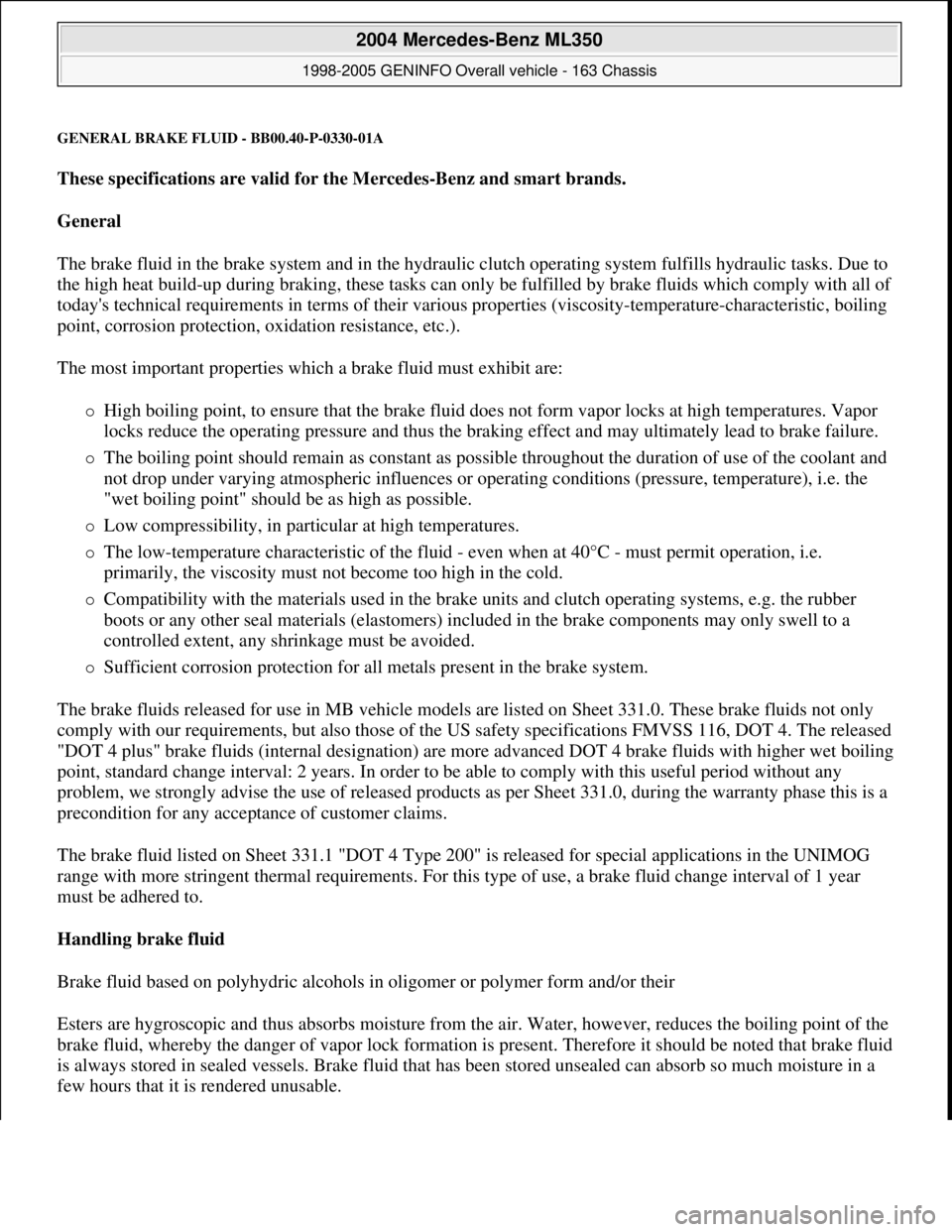
GENERAL BRAKE FLUID - BB00.40-P-0330-01A
These specifications are valid for the Mercedes-Benz and smart brands.
General
The brake fluid in the brake system and in the hydraulic clutch operating system fulfills hydraulic tasks. Due to
the high heat build-up during braking, these tasks can only be fulfilled by brake fluids which comply with all of
today's technical requirements in terms of their various properties (viscosity-temperature-characteristic, boiling
point, corrosion protection, oxidation resistance, etc.).
The most important properties which a brake fluid must exhibit are:
High boiling point, to ensure that the brake fluid does not form vapor locks at high temperatures. Vapor
locks reduce the operating pressure and thus the braking effect and may ultimately lead to brake failure.
The boiling point should remain as constant as possible throughout the duration of use of the coolant and
not drop under varying atmospheric influences or operating conditions (pressure, temperature), i.e. the
"wet boiling point" should be as high as possible.
Low compressibility, in particular at high temperatures.
The low-temperature characteristic of the fluid - even when at 40°C - must permit operation, i.e.
primarily, the viscosity must not become too high in the cold.
Compatibility with the materials used in the brake units and clutch operating systems, e.g. the rubber
boots or any other seal materials (elastomers) included in the brake components may only swell to a
controlled extent, any shrinkage must be avoided.
Sufficient corrosion protection for all metals present in the brake system.
The brake fluids released for use in MB vehicle models are listed on Sheet 331.0. These brake fluids not only
comply with our requirements, but also those of the US safety specifications FMVSS 116, DOT 4. The released
"DOT 4 plus" brake fluids (internal designation) are more advanced DOT 4 brake fluids with higher wet boiling
point, standard change interval: 2 years. In order to be able to comply with this useful period without any
problem, we strongly advise the use of released products as per Sheet 331.0, during the warranty phase this is a
precondition for any acceptance of customer claims.
The brake fluid listed on Sheet 331.1 "DOT 4 Type 200" is released for special applications in the UNIMOG
range with more stringent thermal requirements. For this type of use, a brake fluid change interval of 1 year
must be adhered to.
Handling brake fluid
Brake fluid based on polyhydric alcohols in oligomer or polymer form and/or their
Esters are hygroscopic and thus absorbs moisture from the air. Water, however, reduces the boiling point of the
brake fluid, whereby the danger of vapor lock formation is present. Therefore it should be noted that brake fluid
is always stored in sealed vessels. Brake fluid that has been stored unsealed can absorb so much moisture in a
few hours that it is rendered unusable.
2004 Mercedes-Benz ML350
1998-2005 GENINFO Overall vehicle - 163 Chassis
me
Saturday, October 02, 2010 3:47:57 PMPage 530 © 2006 Mitchell Repair Information Company, LLC.
Page 3176 of 4133

Because the brake fluid also absorbs moisture through the vent bore on the expansion reservoir, the wheel brake
cylinder and the brake hoses, the brake fluid has to be changed for safety reasons at regular intervals, best done
in the spring. When performing this change, make sure that the old fluid is also drained off the clutch system.
Generally, it is vital for the brake/clutch system to be completely drained before being filled with new fluid!
For the above-mentioned reasons, used brake fluid must not be used again.
The brake fluid is amber in color and thus can be easily confused with mineral products.
Therefore, brake fluids should always only be taken from original containers and stored separately from other
mineral oils and fluids.
When performing maintenance operations and repairs on brake parts, make sure that fuel, mineral oil, grease or
suchlike do not enter the brake system. Hydrocarbon-based materials will lead to swelling of the elastomers in
the brake and clutch system and - even in low concentrations - will suffice to cause total failure of the systems.
Only new brake fluid may be used as a rinsing and cleaning agent for the cylinders, lines and the expansion
reservoir of the hydraulic brake system.
Experience shows that before handling brake fluid, the hands must be cleaned and any oil and grease removed.
Brake fluid acts aggressively towards paint and color. In the event of any brake fluid spills or splashes, it must
be rinsed away immediately using copious amounts of water (do not rub it away).
Brake fluid disposal
When disposing of brake fluid, the relevant national specifications must be observed. It is advisable to try to
have the brake fluid disposed of as economic good; this is contingent on
Strict separation of used brake fluid from other materials;
Presence of a disposal channel, which justifies its classification as an economic good, i.e. a proper
alternate usage must be assured.
If this procedure is not possible, used brake fluid is to be disposed of together with any, e.g. paint residue,
solvents and suchlike. Any adding of used oil must be avoided, as it will result in difficulties, if the used oil is to
be recycled; in several countries this is prohibited by the legislators.
MISCELLANEOUS NOTES
NOTES ON SCRAPPING GAS-FILLED HYDRAULIC COMPONENTS - OS00.00-P-1000-01A
all
Unusable gas pressure dampers, spring accumulators, pressure reservoirs and impact absorbers have to be
depressurized before being scrapped according to the respective valid accident prevention regulations. These
safety measures are necessary because gas pressurized hydraulic parts can explode if heat is applied. A risk of
explosion is
given, e.g. when scrapping with cutting torches, smelting or if gas pressurized parts in landfills start
2004 Mercedes-Benz ML350
1998-2005 GENINFO Overall vehicle - 163 Chassis
me
Saturday, October 02, 2010 3:47:57 PMPage 531 © 2006 Mitchell Repair Information Company, LLC.
Page 3177 of 4133
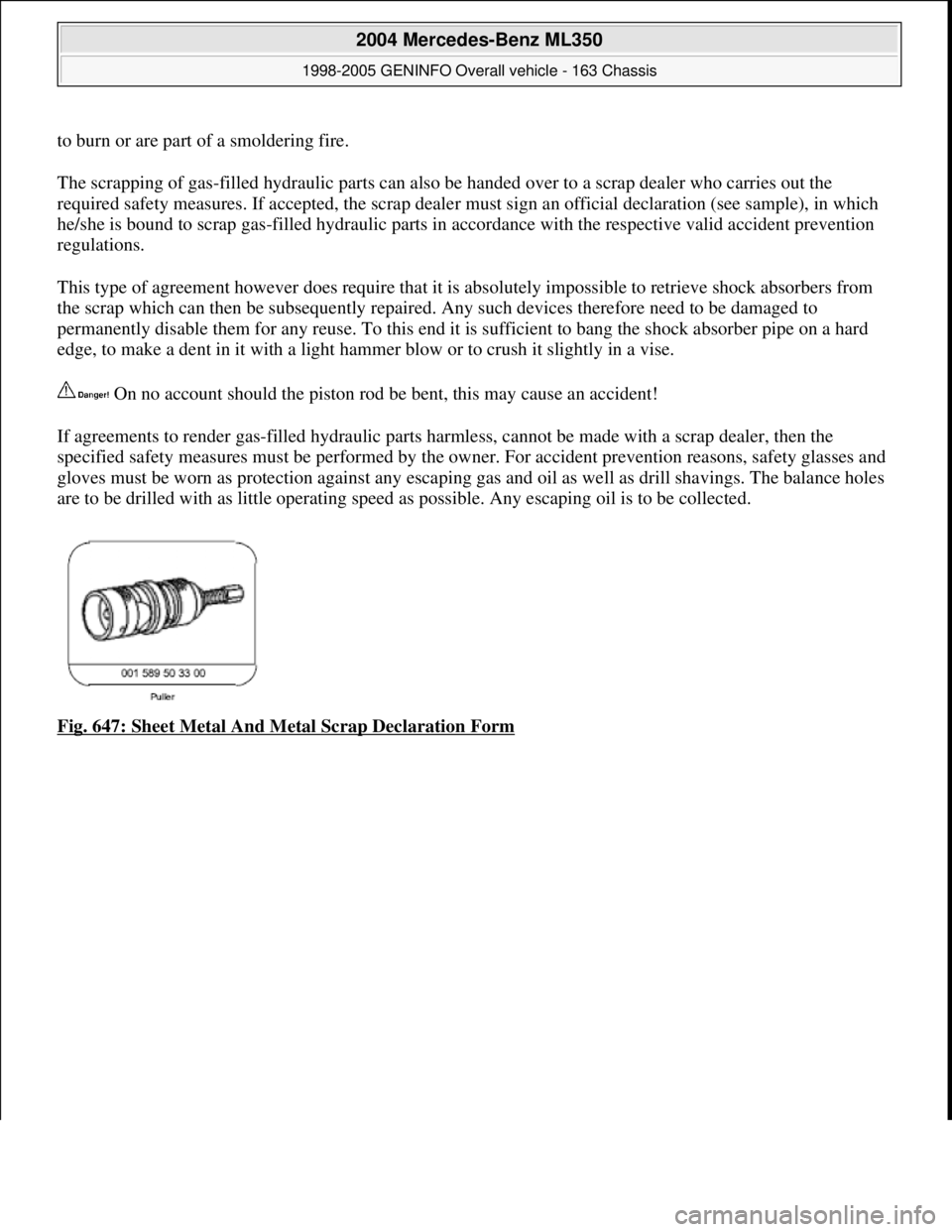
to burn or are part of a smoldering fire.
The scrapping of gas-filled hydraulic parts can also be handed over to a scrap dealer who carries out the
required safety measures. If accepted, the scrap dealer must sign an official declaration (see sample), in which
he/she is bound to scrap gas-filled hydraulic parts in accordance with the respective valid accident prevention
regulations.
This type of agreement however does require that it is absolutely impossible to retrieve shock absorbers from
the scrap which can then be subsequently repaired. Any such devices therefore need to be damaged to
permanently disable them for any reuse. To this end it is sufficient to bang the shock absorber pipe on a hard
edge, to make a dent in it with a light hammer blow or to crush it slightly in a vise.
On no account should the piston rod be bent, this may cause an accident!
If agreements to render gas-filled hydraulic parts harmless, cannot be made with a scrap dealer, then the
specified safety measures must be performed by the owner. For accident prevention reasons, safety glasses and
gloves must be worn as protection against any escaping gas and oil as well as drill shavings. The balance holes
are to be drilled with as little operating speed as possible. Any escaping oil is to be collected.
Fig. 647: Sheet Metal And Metal Scrap Declaration Form
2004 Mercedes-Benz ML350
1998-2005 GENINFO Overall vehicle - 163 Chassis
me
Saturday, October 02, 2010 3:47:57 PMPage 532 © 2006 Mitchell Repair Information Company, LLC.
Page 3267 of 4133
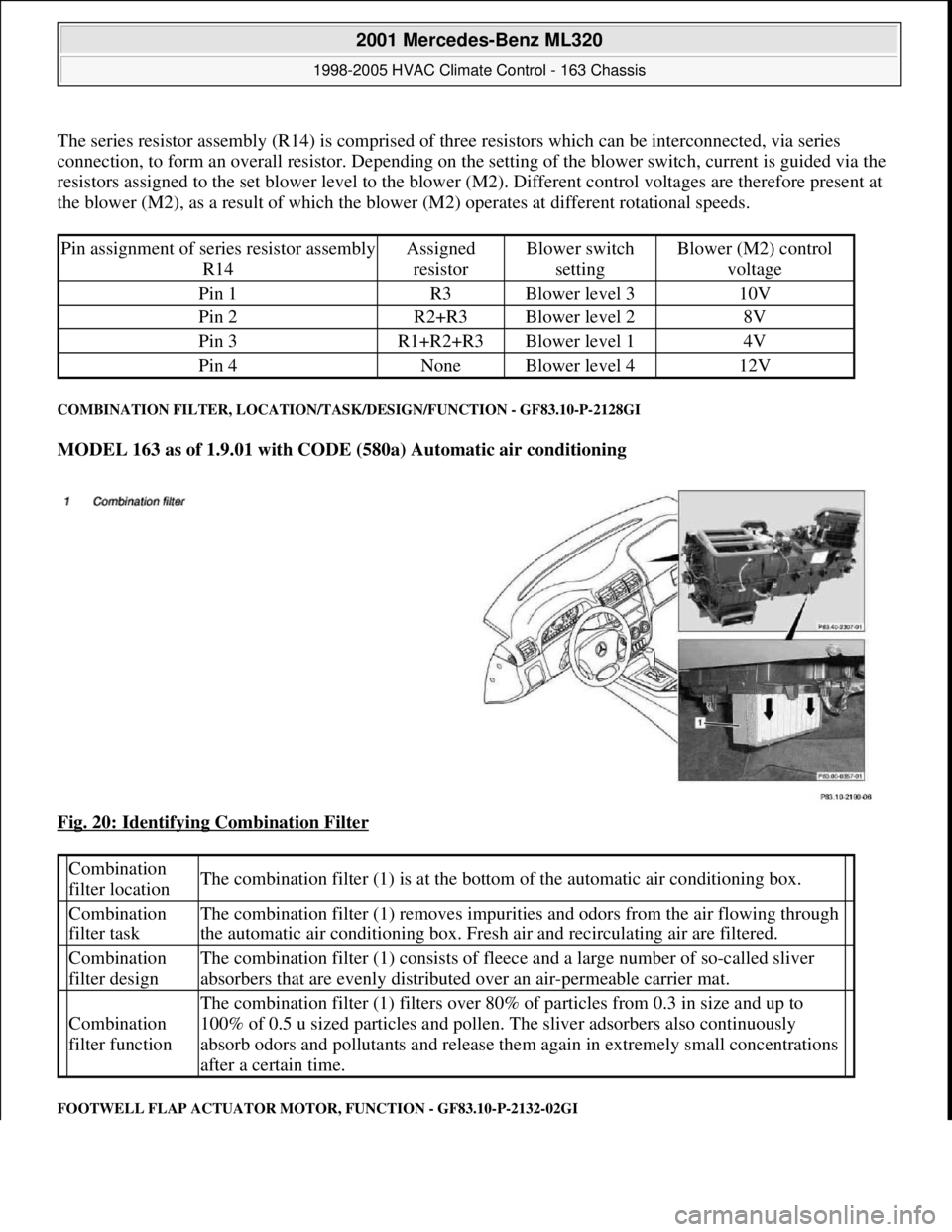
The series resistor assembly (R14) is comprised of three resistors which can be interconnected, via series
connection, to form an overall resistor. Depending on the setting of the blower switch, current is guided via the
resistors assigned to the set blower level to the blower (M2). Different control voltages are therefore present at
the blower (M2), as a result of which the blower (M2) operates at different rotational speeds.
COMBINATION FILTER, LOCATION/TASK/DESIGN/FUNCTION - GF83.10-P-2128GI
MODEL 163 as of 1.9.01 with CODE (580a) Automatic air conditioning
Fig. 20: Identifying Combination Filter
FOOTWELL FLAP ACTUATOR MOTOR, FUNCTION - GF83.10-P-2132-02GI
Pin assignment of series resistor assembly
R14Assigned
resistorBlower switch
settingBlower (M2) control
voltage
Pin 1R3Blower level 310V
Pin 2R2+R3Blower level 28V
Pin 3R1+R2+R3Blower level 14V
Pin 4NoneBlower level 412V
Combination
filter locationThe combination filter (1) is at the bottom of the automatic air conditioning box.
Combination
filter taskThe combination filter (1) removes impurities and odors from the air flowing through
the automatic air conditioning box. Fresh air and recirculating air are filtered.
Combination
filter designThe combination filter (1) consists of fleece and a large number of so-called sliver
absorbers that are evenly distributed over an air-permeable carrier mat.
Combination
filter function
The combination filter (1) filters over 80% of particles from 0.3 in size and up to
100% of 0.5 u sized particles and pollen. The sliver adsorbers also continuously
absorb odors and pollutants and release them again in extremely small concentrations
after a certain time.
2001 Mercedes-Benz ML320
1998-2005 HVAC Climate Control - 163 Chassis
me
Saturday, October 02, 2010 3:23:15 PMPage 23 © 2006 Mitchell Repair Information Company, LLC.